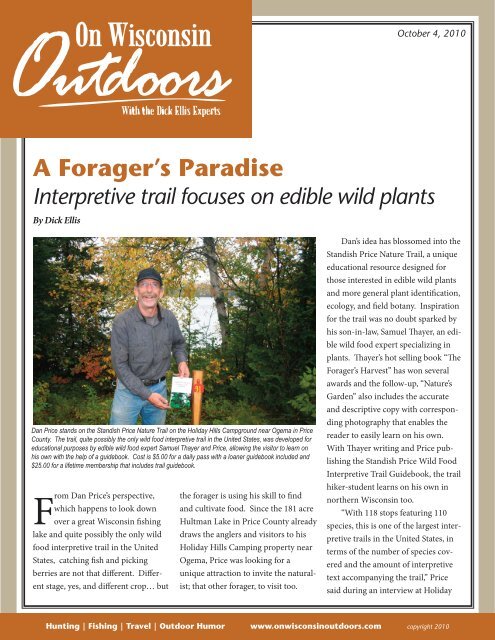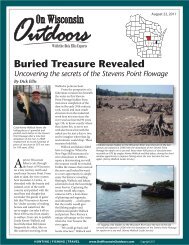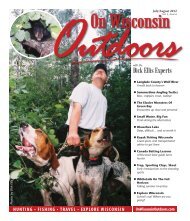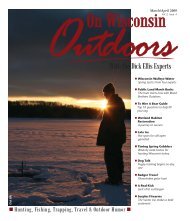A Forager's Paradise Interpretive trail focuses on edible wild plants
A Forager's Paradise Interpretive trail focuses on edible wild plants
A Forager's Paradise Interpretive trail focuses on edible wild plants
Create successful ePaper yourself
Turn your PDF publications into a flip-book with our unique Google optimized e-Paper software.
October 4, 2010<br />
A Forager’s <str<strong>on</strong>g>Paradise</str<strong>on</strong>g><br />
<str<strong>on</strong>g>Interpretive</str<strong>on</strong>g> <str<strong>on</strong>g>trail</str<strong>on</strong>g> <str<strong>on</strong>g>focuses</str<strong>on</strong>g> <strong>on</strong> <strong>edible</strong> <strong>wild</strong> <strong>plants</strong><br />
By Dick Ellis<br />
Dan Price stands <strong>on</strong> the Standish Price Nature Trail <strong>on</strong> the Holiday Hills Campground near Ogema in Price<br />
County. The <str<strong>on</strong>g>trail</str<strong>on</strong>g>, quite possibly the <strong>on</strong>ly <strong>wild</strong> food interpretive <str<strong>on</strong>g>trail</str<strong>on</strong>g> in the United States, was developed for<br />
educati<strong>on</strong>al purposes by <strong>edible</strong> <strong>wild</strong> food expert Samuel Thayer and Price, allowing the visitor to learn <strong>on</strong><br />
his own with the help of a guidebook. Cost is $5.00 for a daily pass with a loaner guidebook included and<br />
$25.00 for a lifetime membership that includes <str<strong>on</strong>g>trail</str<strong>on</strong>g> guidebook.<br />
From Dan Price’s perspective,<br />
which happens to look down<br />
over a great Wisc<strong>on</strong>sin fishing<br />
lake and quite possibly the <strong>on</strong>ly <strong>wild</strong><br />
food interpretive <str<strong>on</strong>g>trail</str<strong>on</strong>g> in the United<br />
States, catching fish and picking<br />
berries are not that different. Different<br />
stage, yes, and different crop… but<br />
the forager is using his skill to find<br />
and cultivate food. Since the 181 acre<br />
Hultman Lake in Price County already<br />
draws the anglers and visitors to his<br />
Holiday Hills Camping property near<br />
Ogema, Price was looking for a<br />
unique attracti<strong>on</strong> to invite the naturalist;<br />
that other forager, to visit too.<br />
Dan’s idea has blossomed into the<br />
Standish Price Nature Trail, a unique<br />
educati<strong>on</strong>al resource designed for<br />
those interested in <strong>edible</strong> <strong>wild</strong> <strong>plants</strong><br />
and more general plant identificati<strong>on</strong>,<br />
ecology, and field botany. Inspirati<strong>on</strong><br />
for the <str<strong>on</strong>g>trail</str<strong>on</strong>g> was no doubt sparked by<br />
his s<strong>on</strong>-in-law, Samuel Thayer, an <strong>edible</strong><br />
<strong>wild</strong> food expert specializing in<br />
<strong>plants</strong>. Thayer’s hot selling book “The<br />
Forager’s Harvest” has w<strong>on</strong> several<br />
awards and the follow-up, “Nature’s<br />
Garden” also includes the accurate<br />
and descriptive copy with corresp<strong>on</strong>ding<br />
photography that enables the<br />
reader to easily learn <strong>on</strong> his own.<br />
With Thayer writing and Price publishing<br />
the Standish Price Wild Food<br />
<str<strong>on</strong>g>Interpretive</str<strong>on</strong>g> Trail Guidebook, the <str<strong>on</strong>g>trail</str<strong>on</strong>g><br />
hiker-student learns <strong>on</strong> his own in<br />
northern Wisc<strong>on</strong>sin too.<br />
“With 118 stops featuring 110<br />
species, this is <strong>on</strong>e of the largest interpretive<br />
<str<strong>on</strong>g>trail</str<strong>on</strong>g>s in the United States, in<br />
terms of the number of species covered<br />
and the amount of interpretive<br />
text accompanying the <str<strong>on</strong>g>trail</str<strong>on</strong>g>,” Price<br />
said during an interview at Holiday<br />
Hunting | Fishing | Travel | Outdoor Humor www.<strong>on</strong>wisc<strong>on</strong>sinoutdoors.com copyright 2010
Hills Camping last week. “It is also, as<br />
far as we know, the <strong>on</strong>ly such <str<strong>on</strong>g>trail</str<strong>on</strong>g> that<br />
<str<strong>on</strong>g>focuses</str<strong>on</strong>g> <strong>on</strong> <strong>edible</strong> <strong>wild</strong> <strong>plants</strong> in the<br />
United States, featuring 71 species.”<br />
Price said that Thayer, who is<br />
sometimes referred to as the “21st<br />
century EueLl Gibb<strong>on</strong>s” and married<br />
his daughter Melissa three years ago,<br />
began taking an inventory <strong>on</strong> the<br />
property <strong>on</strong>e year ago of everything<br />
<strong>edible</strong> that was growing <strong>wild</strong>. With<br />
the survey and photography completed,<br />
he wrote the guidebook for the<br />
anticipated visitors over the course of<br />
the winter.<br />
The <str<strong>on</strong>g>trail</str<strong>on</strong>g> length is less than <strong>on</strong>ehalf<br />
mile and follows an old undeveloped<br />
horse path up and down small<br />
hills and across a short drainage area<br />
that is wet at times. Price decades ago<br />
was a Farrier, a shoer of horses and<br />
also logged the northwoods with<br />
horses. Do not expect, he said, a<br />
gravel path <strong>on</strong> the <str<strong>on</strong>g>trail</str<strong>on</strong>g> with bridges<br />
and culverts.<br />
“It is a walk in the woods you<br />
might say,” Price said. “What <str<strong>on</strong>g>trail</str<strong>on</strong>g> visitors<br />
can expect to experience essentially<br />
is a course with no instructor for<br />
students of <strong>edible</strong> <strong>wild</strong> <strong>plants</strong> and field<br />
botany in general. As you walk al<strong>on</strong>g<br />
the <str<strong>on</strong>g>trail</str<strong>on</strong>g>, you will see numbered markers<br />
that corresp<strong>on</strong>d with entries in the<br />
guidebook. At each stop the user can<br />
read the appropriate entry to learn<br />
about the natural history and edibility<br />
of the plant indicated. The Standish<br />
Price <str<strong>on</strong>g>trail</str<strong>on</strong>g> is a walking classroom.<br />
Rather than cater to casual hikers, this<br />
<str<strong>on</strong>g>trail</str<strong>on</strong>g> is for those engaged in active<br />
learning about <strong>wild</strong> <strong>plants</strong>.”<br />
“This set-up provides some enor-<br />
mous advantages to the user,” he said.<br />
“First because it eliminates the presence<br />
of an instructor, it’s cost effective<br />
($5.00 daily or $25.00 seas<strong>on</strong>al pass).<br />
A traditi<strong>on</strong>al weekend botany field<br />
course costs hundreds of dollars. Sec<strong>on</strong>d,<br />
it’s c<strong>on</strong>venient; the student comes<br />
whenever he or she wishes. And<br />
third, because there is no instructor, it<br />
forces the participant to learn rather<br />
that listen.”<br />
Price said that the Standish Price<br />
<str<strong>on</strong>g>Interpretive</str<strong>on</strong>g> Trail is designed to make<br />
the user slow down and learn at a realistic<br />
pace, as well as to facilitate the<br />
observati<strong>on</strong> and interacti<strong>on</strong> that promote<br />
effective learning. The user decides<br />
when to learn, what to learn,<br />
and at what pace. Being l<strong>on</strong>ger than<br />
most interpretive <str<strong>on</strong>g>trail</str<strong>on</strong>g>s, Price said expect<br />
to invest many hours to complete<br />
the Standish Price <str<strong>on</strong>g>Interpretive</str<strong>on</strong>g> Trail.<br />
There is no need to walk the <str<strong>on</strong>g>trail</str<strong>on</strong>g> in<br />
<strong>on</strong>e day.<br />
“The <str<strong>on</strong>g>trail</str<strong>on</strong>g> is not intended to be<br />
used <strong>on</strong>ly <strong>on</strong>ce nor is it intended to be<br />
used by itself,” said Price. “Users of<br />
the <str<strong>on</strong>g>trail</str<strong>on</strong>g> should own several field<br />
guides and plant references. Perhaps<br />
you’d want to carry “Michigan Trees”<br />
with you <strong>on</strong> <strong>on</strong>e visit and “Newcomb’s<br />
Wildflower Guide” <strong>on</strong> another. After<br />
learning new <strong>plants</strong> <strong>on</strong> the S.P. Trail,<br />
you’ll want to commit your identificati<strong>on</strong><br />
of each species to memory by<br />
finding and recognizing the pant <strong>on</strong><br />
your own. You can do this <strong>on</strong> the S.P.<br />
<str<strong>on</strong>g>trail</str<strong>on</strong>g>, as many of the <strong>plants</strong> occur repeatedly<br />
al<strong>on</strong>g it. But you w<strong>on</strong>’t want<br />
to miss some of the other spectacular<br />
hikes available in the area, (Tim’s Hill,<br />
Wisc<strong>on</strong>sin’s highest point, is in the<br />
area) and look for <strong>plants</strong> that you have<br />
just learned. Compare them with the<br />
field guides to make sure that you<br />
have correctly identified them.”<br />
“As you look at each marker, you<br />
may need to read the descripti<strong>on</strong> in<br />
the guidebook to determine which of<br />
the <strong>plants</strong> in the vicinity of the stake is<br />
its subject,” Price said. “While the<br />
<str<strong>on</strong>g>trail</str<strong>on</strong>g> <str<strong>on</strong>g>focuses</str<strong>on</strong>g> <strong>on</strong> <strong>edible</strong> <strong>plants</strong>, it also<br />
covers many n<strong>on</strong>-<strong>edible</strong> <strong>plants</strong>. It is<br />
designed with the philosophy that, in<br />
order to learn <strong>edible</strong> <strong>plants</strong>, you must<br />
learn <strong>plants</strong> in general (However, all<br />
collecting of <strong>plants</strong> is forbidden al<strong>on</strong>g<br />
the <str<strong>on</strong>g>trail</str<strong>on</strong>g>).”<br />
After a few years and a dozen visits<br />
to the <str<strong>on</strong>g>trail</str<strong>on</strong>g>, Price said, the user will<br />
have learned a vast amount about<br />
botany, ecology and <strong>edible</strong> <strong>wild</strong> <strong>plants</strong>.<br />
The Standish Price <str<strong>on</strong>g>Interpretive</str<strong>on</strong>g> Trail is<br />
open May 1 through October 31.<br />
Cost is $25.00 for a lifetime membership<br />
(individuals or married couples<br />
and their minor children), which includes<br />
guidebook. If the user anticipates<br />
a single visit, cost is $5.00, with a<br />
loaner copy of the guidebook available<br />
at the <str<strong>on</strong>g>trail</str<strong>on</strong>g> and camping office.<br />
C<strong>on</strong>tact Dan Price at W2706 Hultman<br />
Lake Road, Ogema, WI 54459,<br />
714-922-0089. Or c<strong>on</strong>nect at www.holidayhillscamping.com/nature<str<strong>on</strong>g>trail</str<strong>on</strong>g>.html<br />
or info@holidayhillscamping.com. Purchase<br />
Samuel Thayer’s books at Barnes<br />
& Noble’s, through Amaz<strong>on</strong> or by<br />
googling “Forage Harvest” Copies are<br />
also available at the Standish Price <str<strong>on</strong>g>Interpretive</str<strong>on</strong>g><br />
Trail.<br />
More outdoors? C<strong>on</strong>nect with us at www.<strong>on</strong>wisc<strong>on</strong>sinoutdoors.com.<br />
O W O<br />
Hunting | Fishing | Travel | Outdoor Humor www.<strong>on</strong>wisc<strong>on</strong>sinoutdoors.com copyright 2010







